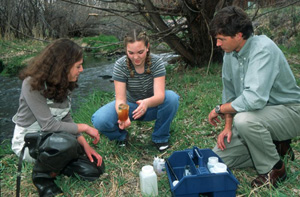"Understanding Science," a Web site funded by the National Science Foundation (NSF), offers a window to a better understanding about how dynamic and creative the scientific process really is.
"Understanding Science" Web site, University of California Museum of Paleontology
Not Just a Guy in a White Coat
News story originally written on February 26, 2009
Do you know what science is? Do you know what science isnít?†
The process of doing science is often described with five steps: Ask a question, form a possible reason why something is happening, do an experiment, collect data, and draw a conclusion. But science is much more than those steps. Itís dynamic and creative. Thatís what a new web site called Understanding Science explains.
Instead of the five-step process, the web site explains how science works with an interactive chart. Head to the site and learn about how and why scientists are able to explore and discovery new things about our world and the Universe. Learn about the many ways that ideas are tested out and how scientists work in teams to analyze data and share ideas. There are many possible benefits and outcomes that result from making science happen.
The Web site shares what science is and how it works using real-life examples from the world of scientific research. The site even offers a chance to consider whether activities like astrology are, or are not, science.
Understanding Science is for the general public and educators. †
Last modified April 13, 2009 by Lisa Gardiner.
You might also be interested in:

Being a scientist is fun. You get to do experiments and think of reasons why things might be happening a certain way. Being a scientist is also hard work. After a scientist comes up with a reason why something
...more
Scientists have learned that Mount Hood, Oregon's tallest mountain, has erupted in the past due to the mixing of two different types of magma. Adam Kent, a geologist at Oregon State University, says this
...more
The Earth's mantle is a rocky, solid shell that is between the Earth's crust and the outer core. The mantle is made up of many different reservoirs that have different chemical compositions. Scientists
...more
Some faults look strong and like they wouldnít cause an earthquake. But it turns out that they can slip and slide like weak faults causing earthquakes. Scientists have been looking at one of these faults
...more
The sun goes through cycles that last approximately 11 years. These solar cycle include phases with more magnetic activity, sunspots, and solar flares. They also include phases with less activity. The
...more
Studying tree rings doesn't only tell us the age of that tree. Tree rings also show what climate was like while the tree was alive. This means that tree rings can tell us about climates of the past. Two
...more
Earth's first life form may have developed between the layers of a chunk of mica sitting like a multilayered sandwich in primordial waters, according to a new hypothesis. The mica hypothesis, which was
...more















